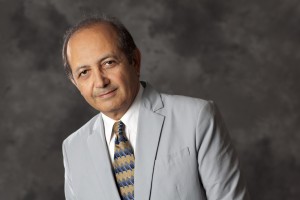Viterbi professor featured by NASA
The National Inventors Hall of Fame and the History Channel’s Modern Marvels program has named Professor Behrokh Khoshnevis research as one of the top 25 best inventions of 2006. Khoshnevis, a professor in USC’s Viterbi School of Engineering presented his work in Washington D.C. on July 23, NASA’s annual Technology Day.

Out of this world · As well as teaching, Professor Behrokh Khoshnevis also serves as a Felllow member of the Institute of Industrial Engineering. – Photo courtesy of USC Viterbi School of Engineering
Khoshnevis’ research is based on his invention of the groundbreaking automated construction method called “Contour Crafting,” which creates large scale structures layer by layer, similar to that of the process of 3-D Printing.
For his work with NASA, Khoshnevis tailored the process of “Contour Crafting” for extraterrestrial applications.
“I was looking at areas where my technology could be used besides the applications in building construction,” Khoshnevis said. “I thought about construction on the moon or on Mars, and I noticed that primarily, everything is based on taking stuff from Earth.”
Khoshnevis, in collaboration with NASA, is developing landing pads for the moon and Mars.
“So far, everything that has landed on the moon and Mars has landed on soft soil, and that is pretty dangerous… You need a flat surface which is also strong, which is also capable of handling high temperature of the exhaust fumes.”
If successful, Professor Khoshnevis’ endeavors could vault USC onto the global stage.
“Professor Khoshnevis’ research really establishes USC as a global community, and I think many students will be inspired by his passion to further pursue their own goals,” said Ying Ying Lei, a sophomore majoring in electrical engineering.
Brian Weiniger, a junior majoring in astronautical engineering, also praised Khoshnevis’ research.
“Colonizing the moon can be done in many ways. Rather than sending rockets to build lunar outposts piece by piece, this new technology holds the capability to build everything on the moon while using materials that are already there,” Weiniger said. “It goes to show how brilliant the professors are at USC. Having role models like Khoshnevis teach at our school is inspiring for students to push the envelope and create the ideas that will mold our future.”
Khoshnevis teaches both industrial and systems engineering, and civil and environmental engineering classes, and is the director of the Center for Rapid Automated Fabrication Technologies, as well as the Manufacturing Engineering Graduate Program at USC. His work, however, is not limited to the field of engineering.
“There are a lot of students sending me emails who want to be a part of the technology development,” Khoshnevis said. “There are students from architecture, engineering, business school, even social sciences and the arts. There is a sense that we are on the edge of something that could change the face of civilization.”
While his research has already achieved significant results, Khoshnevis has even loftier expectations for it.
“What I basically envision and hope is that one [of] the most major technologies that will have a very significant impact on the well-being of the whole population is about to emerge out of this activity,” he said.
